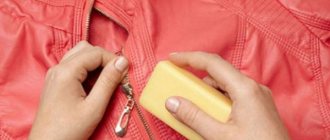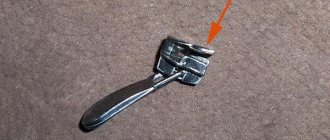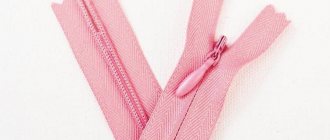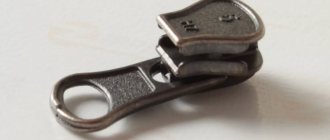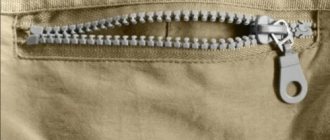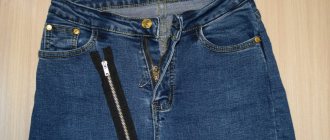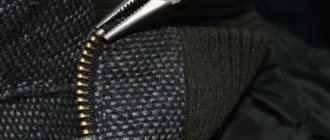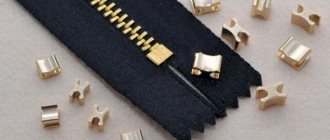What is this text about? In this text we will answer the following questions: how to unbutton a jacket if the lock is stuck, what to do if the lock on the jacket is stuck, the zipper on the jacket is stuck, what to do. The plastic zipper does not fasten well, what to do. How to fix a zipper if the slider has completely come off How to fix a zipper? Even a fully developed old zipper can cause the slider to jam and slide poorly. The zipper on clothing is convenient and therefore popular. The zipper on my jacket often got stuck. As for me, this is the first aid to new and too old lightning. If the zipper starts to come apart, then you can fix it with a hammer and pliers. When a zipper gets stuck, it doesn’t mean it’s time to change it.
Particles of soap or paraffin will penetrate inside, and the zipper dog will walk more softly. This is a tried and tested remedy. The zipper may also not fasten well because it does not fit the type of fabric. For thick fabrics, a thick zipper is suitable; for thin fabrics, a narrow one is also suitable. It happens that the teeth of plastic zippers melt when they come into contact with a hot iron. All that remains is to throw away such lightning. During storage, the zipper on the clothing may become bent, which also makes fastening difficult.
A zipper can get stuck at the most crucial moment, when in a hurry to get to work you quickly put on a jacket or your favorite leather boots. For a zipper to function properly, it must be made without flaws. The runner needs to be proportionate so that it can easily “walk” along the teeth and at the same time interlock them. If the new lock sticks when unfastening and fastening, then the best option is to lubricate the zipper.
To lubricate the zipper, a regular wax or paraffin candle is quite suitable. You just need to run it over the interlocking teeth a few times, and the situation immediately improves. First, you need to thoroughly clean the teeth with a brush, dry them, and only then lubricate the zipper.
How to unfasten a zipper if it comes apart, what to do to prevent the zipper from coming apart: tips
Sometimes on a zipper that has come apart, the slider gets stuck at the top or in the middle. What can be done in this case?
The technology depends on the type of zipper.
Detachable (used on sweaters, jackets or other outerwear):
- insert the lower ends of the fastener into the square clamp
- hold the dog by its base, not by its decorative keychain
- pressing the slider to the links, move it down smoothly and slowly
- Use your other hand to constantly hold the clasp
- Having reached the latch, carefully engage it with the slider
- unzip
One-piece (sewn into jeans, skirts, trousers, bags, wallets):
- release the stoppers at the top of the fastener
- smoothly slide the slider to the edge of the tape
- try not to get the fabric between the teeth and the dog
- remove the carriage from the zipper
Unfasten the loose zipper
Now check whether the fastener can be repaired. For this:
- manually connect the lower ends at the clasp
- with your other hand, grab the base of the slider
- holding the lower end, slowly move the pawl up the zipper
- if during this action the links of the zipper do not connect, it must be replaced
In the case when adhesion between the fastener links does occur, there is a chance to repair the zipper yourself. It happens that lightning diverges from above. This problem especially often occurs with jeans or skirts.
In emergency cases, this method can help:
- insert an elastic band or wire ring into the dog
- fasten the zipper
- place the elastic band (ring) on the button
- thread the button through the loop
To ensure that the zipper serves you for a long time and does not break, use it correctly:
- do not pull the pawl with all your might and do not pull it back when fastening/unfastening
- Before fastening the zipper, straighten the sides of the product so that there are no stretched areas
- in cases where the lock is too tight, lubricate it with a suitable product or rub the teeth with a graphite pencil lead
- avoid putting too much pressure on the fastener (buy clothes that are not too tight, don’t carry a lot of things in your bag)
- Periodically clean the clasp from dirt using a brush
- Always zip up the item before washing and turn it inside out
- fold things in such a way that the zipper does not bend
- When ironing clothes, avoid touching the fastener with a hot iron
How to quickly insert a pawl into a zipper?
If you encounter such a problem, try the dinner fork life hack. As you can see, everything is quite simple: you just need to place the slider on the tines of the fork and at the same time thread both parts of the zipper. Afterwards, all that remains is to carefully remove the cutlery. This unusual tip was shared by a user on Reddit.
Interesting materials:
What can be seen on MRI of blood vessels? What can be seen on an ultrasound of lymph nodes? What is included in the base for calculating vacation pay? What is included in HR administration? What is included in the zero level channel? What is included in an anti-binge drip? What's included in a hockey uniform? What is included in the global transport system? What is included in vacation payments when calculating? What is included in permanent makeup?
Recommendations for washing
- You should zip up all zippered sections, turn the garment inside out, or use laundry bags before putting the item in the machine.
- Before washing, make sure that the zippers are completely closed and the sliders are secured. You can fasten and secure the zipper with a pin in case it comes undone during washing.
- Wrap the sliders and teeth (give them minimal contact with the fabric) to provide protection from severe physical impact, friction and abrasion.
- Dry clothes thoroughly and promptly after washing.
- Before actually loading the item into the machine, you can perform a test test to determine whether the zippers and fasteners are machine washable.
If the lightning breaks
Tide cleaners
First of all, you need to return the zipper slider to its original position, that is, to the beginning of the fastener. Next, take a pair of pliers or tweezers and gently squeeze the slider on each side, and then slightly squeeze the straight part of the slider on the sides, which will improve its grip on the zipper teeth. If you don’t have pliers at hand, a similar operation can be carried out using a hammer, gently tapping the lock.
outsideonline
This method will almost certainly work, but, unfortunately, you won’t be able to use it several times - after 1-2 times the slider will most likely break.
Insert the zipper into the side seam of the trousers
Ways to fix a zipper at the base
The reason for the zipper breaking at the very base is the separation of fabric lint. The material that holds the lock is fraying.
To restore its integrity and continue to use the lock, it is enough to use a cunning technique.
Repairing the zipper at the base:
- Gather the fabric at the base.
- Soak with nail polish.
- Let it dry in the correct position.
- Re-treat with nail polish.
Important! If the lock is in a visible place, the varnish should be matched to the color of the lock's fabric. A red smeared spot on a black handbag will look extremely awkward and catchy, even considering that the base of the zipper is not in plain sight.
Glue is often used instead of nail polish. This is a great alternative because the adhesive is more durable and the material becomes harder, making the fastener easier to use.
Shoe glue, or “Moment,” is suitable for these purposes. Glue is not suitable for joining paper.
How to lubricate a zipper on a bag to make it move better
If you experience that your zipper sometimes jams or jams, this problem is also easy to fix. Like almost any mechanism, the performance of a zipper can be improved by lubricating it. But what - it depends on the material of the fastener. Let's look at all the available options:
- A plastic
zipper can be treated with a regular paraffin candle or any soap (the main thing is that it is dry and hard enough). Walk along the back of the zipper and you will quickly notice how easy it is to close the zipper. Wax crayons are also suitable and can be used similarly to a paraffin candle. If the problem occurred outside the home, try using hygienic lipstick for the same purpose. - The metal
fastener will be saved by the most ordinary lard. Especially if your bag is made of genuine leather - natural fat will not harm it. Gently run a piece of lard along the teeth, and the zipper will fasten easily and effortlessly. Excess fat can then be removed with a paper towel. However, if the accessory is made of textiles, be careful that the lard does not leave greasy stains. - To make the iron
zipper easy to fasten, you should use a little camphor oil. It is enough to apply a little on a cotton swab or disk and walk it along the zipper. Also here a pencil lead will come to the rescue, with which you need to go along the teeth. But only if the lightning is black or gray.
The most important thing is that if the clasp suddenly begins to perform its function poorly, try not to get nervous and not tug the lock too hard. In most cases, this will only make the situation worse. And with a plastic zipper - it will quickly break the pawl and teeth.
There are also methods of care and prevention that will keep the zipper in working condition for as long as possible:
- Immediately after purchase, pay attention to the design
of the clasp. Carefully open and close the lock several times so that the dog slides easily and without obstacles. - Regularly try to inspect and clean
the space between the teeth from dust, dirt, and hair (if you have pets at home). - If you have a textile bag and want to iron it after washing, do not touch the zipper with a hot iron
, especially if it is plastic. High temperatures cause plastic to deform. - If the zipper is stuck, don't worry, carefully check if any objects are stuck
, lubricate the teeth depending on the material of the fastener. Attempts to tug or pull it can only lead to breakage. - Plastic zippers can be damaged as a result of mechanical damage
or falling of the bag. - If you notice that one or more teeth are missing
, it is better to change the fastener immediately. If the teeth are just bent, you can carefully try to tap them with a hammer, first placing a cutting board or other similar hard object under the fastener. If this does not help, all that remains is to replace the zipper.
Remember to carefully inspect all accessories before purchasing a bag.
If at this stage you already see distortions or damaged fragments somewhere, it is better to choose another accessory. A broken zipper is not a death sentence for your favorite bag. Any studio or small workshop will be able to change the zipper quickly and not too expensively. But most often you can cope with the breakdown yourself and at home. And for this you do not need any special skills or special tools. A few minutes of your time is enough.
| David Jones bag | David Jones bag | Passo Avanti handbag | Poshete bag |
Share:
What to do if there are not enough teeth?
The lack of teeth is one of the reasons for the inconvenience when fastening. Over time, they fall out, leaving behind gaps that impede the passage of the slider.
We close the gaps on the plastic zipper:
- We buy thick fishing line.
- We drag it to the place where the tooth fell out.
- We wind it several times so that the size matches the rest of the teeth.
- We secure it with a lighter, after making a small knot.
This method will help make fastening easier, postponing a visit to the studio.
A metal zipper can only be repaired using similar teeth. They can be found on an old zipper that is no longer used.
It is important that the size of the teeth correspond to those available, otherwise the procedure will not be beneficial.
Insert the teeth into the metal zipper:
- We separate the required number of teeth of a suitable size from the old zipper.
- We put them in place of the spaces and clamp them with pliers.
- Check the strength and re-tighten if necessary.
Important! It happens that the teeth do not fall out completely, but begin to interfere with the normal passage of the slider. The lock is opened and placed on a hard surface, after which it is lightly tapped with a hammer on the teeth. This should bring them back to their original position. This method only works on metal zippers!
If the slider gets stuck
Often the slider gets stuck due to foreign materials getting into it, such as a pad that is too wide. If this happens regularly, the fold line of the lining can be secured with a few stitches at the desired distance from the zipper.
apartment therapy
If the slider gets stuck for no apparent reason, take a simple pencil with a graphite rod and rub it on the zipper teeth in the place where the lock is stuck. Similarly, using a cotton swab, you can apply Vaseline, lip balm or soap to the teeth.
Life hack: how to store zippers
Repairing a lock on outerwear
A jammed zipper on a jacket is not uncommon. There are several reasons for this:
- “grabbing” a piece of lining with a slider;
- foreign particles between the cloves;
- weakening the slider pressure;
- deformation of individual teeth.
The easiest and fastest repair method is lubrication. A candle or a piece of soap can be used as a lubricant. After inspecting the lock and making sure that nothing is preventing it from closing, you need to carefully run a candle over the teeth. Then “drive” the slider in both directions. Usually this is enough for the zipper to work without problems.
If foreign particles (crumbs, blades of grass, residues of washing powder) get in, before lubricating, clean the working part of the lock with an old toothbrush.
Teeth do not close or are moving apart
This is one of the most common and annoying problems. First, try repeating the trick with a pencil and soap, maybe this will improve the glide and allow the teeth to close properly.
If this does not help, then something is preventing the slider from working properly. Look to see if there is any thread or fabric stuck in the lock, carefully inspect all the teeth, maybe one of them is bent. In this case, you need to straighten it with pliers, and the zipper will close normally.
If nothing has gotten into the fastener and all the teeth are straight, the problem may be with the slider itself. Over time, the sliders become loose and no longer hold the teeth together. Take the pliers and squeeze the slider until it catches the teeth again.
Washing clothes with zippers
An open zipper is the main enemy of any fabric. The teeth or sharp edges may accidentally cut into other clothes while they are being loaded into the washer or dryer. To avoid pinholes and unnecessary wear, all zippers should be closed before starting the process, especially with mixed loads. This rule applies not only to jeans, trousers and jackets. All items with loops or sharp hooks need careful washing. These metal parts can not only damage other clothing, but also damage themselves. A great way to extend the life of any clothes with fasteners is to purchase a laundry bag; it will protect your laundry from unnecessary friction and damage.
Mechanical damage
If the zippers are not closed during washing, the following parts will be damaged:
- slider
- Retainer
- zipper teeth
How to repair a slider?
A common problem with any fastener: breakage of the slider. The reasons for this type of failure vary.
Possible reasons for the slider failure:
- Poor quality alloy.
- Use of low quality material in production.
- Inappropriate material for the slider compared to the zipper teeth.
- Careless handling when fastening and unfastening the product.
Whatever the cause of the breakdown, you should try to solve the problem yourself. Often, the cause is the divergence of the edges of the slider.
They stretch, the process of movement worsens, the slider flies off when fastened.
How to fix a slider - step by step instructions:
| № | Actions | Detailed description |
| 1 | Removing the slider | Use an awl to move the outer holders on the zipper. Carefully pull out the slider |
| 2 | Looking through the slider | Look at the light: is the degree of clamping of the edges of the slider different? If different, you need to align them by pinching the wide edge |
| 3 | Clamping the edges | Using pliers, we press the edges of the slider one by one, making them narrower. If one of the edges is more loosened, it must be leveled with the narrow edge |
| 4 | Inserting a slider | We carefully return the part to its place, checking how successfully the repair was completed |
Important! You cannot squeeze the slider in the middle, this will lead to its final breakage. Only clamp at the edges. Do not overdo it so as not to damage the part. If you close the edges all the way, you will not be able to use the lock.

